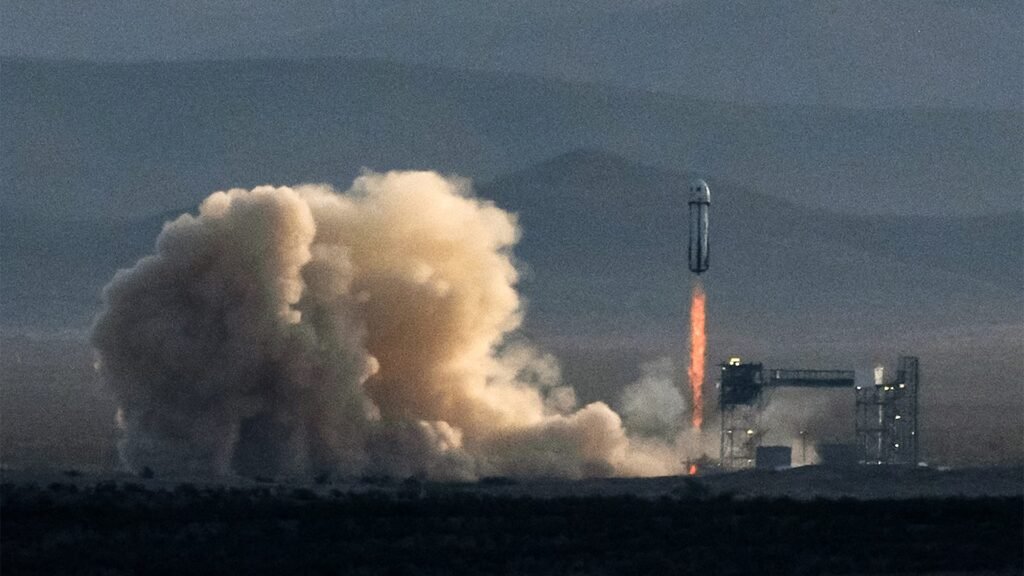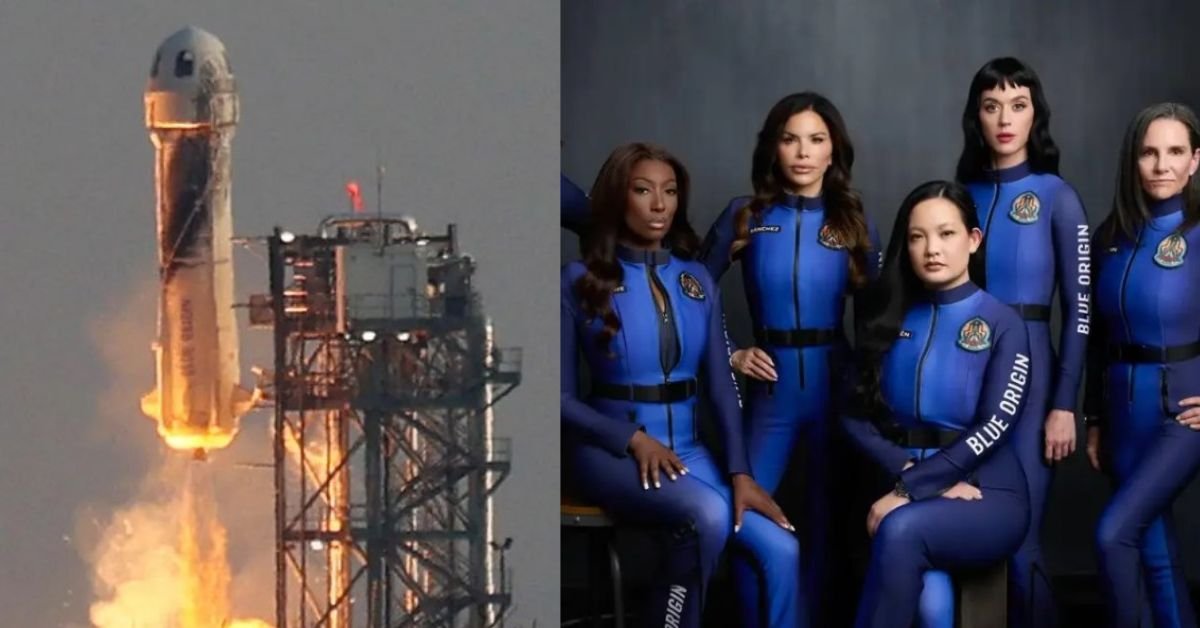On Monday morning, six women, including pop icon Katy Perry, soared to the edge of space aboard Blue Origin’s New Shepard rocket. The mission marked a milestone—not just for space tourism, but also for representation in an industry long dominated by men. Yet, despite the celebratory headlines and celebrity appeal, the event has sparked a deeper conversation about space travel, access, and the optics of billionaire-funded missions.
While the all-female crew made history, critics question whether the mission was a step forward for women in science and exploration, or just a high-priced publicity stunt designed to promote Jeff Bezos’s space company.
Blue Origin’s 11th Crewed Mission

The launch took place at 9:30 a.m. ET from Blue Origin’s site in Van Horn, Texas. This marked the 11th human flight of the New Shepard spacecraft—a fully reusable, suborbital rocket developed by Blue Origin, the private space venture founded by Amazon billionaire Jeff Bezos.
What made this trip unique was the makeup of its passengers: all six were women, a rarity in the spaceflight world. Among them were:
- Katy Perry, a global pop superstar known for hits like Firework and Roar.
- Lauren Sánchez, a former broadcast journalist and the current fiancée of Jeff Bezos.
- Gayle King, CBS Mornings co-host and veteran journalist.
- Aisha Bowe, a former NASA aerospace engineer.
- Amanda Nguyen, a bioastronautics researcher and civil rights activist.
- Kerianne Flynn, a film producer.
Together, they became the first all-women crew to fly on a commercial spaceflight—a powerful symbol given that women account for only about 15% of all space travelers to date.
Katy Perry Space Journey: A Symbol of Progress or a Pricey Publicity Play?
While the image of Katy Perry in space may seem like a scene straight out of a futuristic pop video, her participation in the mission has raised serious questions about the commercialization of space.
For many, the mission looked more like a brand strategy than a scientific breakthrough. Gayle King, who flew alongside Perry, acknowledged the ethical concerns, telling CBS that she’s been critical of some of Bezos’s decisions—including his influence over the Washington Post, where he’s been accused of compromising editorial independence, and his perceived alignment with controversial political figures.

Bezos, who was on-site to celebrate the flight, has long positioned Blue Origin as a visionary company aiming to make space accessible. But critics argue that his company’s space tourism efforts mainly benefit the ultra-wealthy while doing little to further scientific progress.
As The New York Times put it, “If the flight proves anything, it is that women are now free to enjoy capitalism’s most decadent spoils alongside the world’s wealthiest men.”
What Counts as Going to Space?
The crew traveled roughly 62 miles above sea level, reaching just past the Kármán line, the commonly accepted boundary of space. The total trip lasted about 11 minutes, including a few minutes of weightlessness and breathtaking views of Earth’s curvature.
But does this make the passengers true astronauts?
Some scientists and space professionals say no. The flights are suborbital, meaning they don’t achieve the speed or trajectory needed to enter a stable orbit around Earth. Instead, the spacecraft simply arcs up and down—a quick thrill ride rather than a scientific mission.
That’s why critics often draw a clear line between government astronauts, who spend months aboard the International Space Station, and commercial space tourists like Perry and Sánchez, whose trips are more about the experience than exploration.
The Women on Board: More Than Just Celebrities
While the media spotlight focused heavily on Katy Perry’s space flight, the crew included women with serious credentials in science and activism.
Aisha Bowe, for example, is a former NASA engineer who has broken numerous barriers as a Black woman in aerospace. Amanda Nguyen is a Nobel Prize nominee and civil rights advocate who helped draft the federal Sexual Assault Survivors’ Bill of Rights. These passengers weren’t just celebrities—they were pioneers in their own right.
And that’s important to note. Representation matters, especially in fields like aerospace, where women, especially women of color, remain underrepresented. Blue Origin’s decision to include women from diverse backgrounds sends a powerful message, even if the underlying motives remain debatable.
The Economics of Space Tourism
One of the biggest criticisms of space tourism is accessibility. While Blue Origin didn’t reveal how much tickets for this flight cost, similar trips aboard Virgin Galactic have been priced between $250,000 and $450,000 per seat.
It’s unclear whether Katy Perry or any of the other passengers paid for their tickets, though Blue Origin has previously flown some celebrities for free. Still, the exclusivity of the experience reinforces the idea that space travel remains a luxury for the rich and famous.
The broader concern is that space, once the domain of scientific research and national pride, is becoming a playground for billionaires like Bezos, Elon Musk (SpaceX), and Richard Branson (Virgin Galactic). These private ventures are racing to dominate space tourism, often with more focus on profits and branding than innovation or exploration.
Is There a Greater Purpose Behind Celebrity Flights?
Proponents argue that celebrity spaceflights help to normalize space travel and inspire public interest in science and technology. There’s some truth to that. When William Shatner, who famously played Captain Kirk on Star Trek, flew with Blue Origin in 2021, he described the experience as “profoundly moving.” His emotional testimony sparked renewed conversations about humanity’s place in the universe.
Similarly, having someone like Katy Perry, who commands a massive fanbase and global influence, publicly share her space experience could help bring awareness and enthusiasm to aerospace and STEM careers, especially among young girls.
But is that enough?
Critics say these flights often lack meaningful outcomes. There’s little scientific research being conducted, no major data being collected, and no infrastructure being built to benefit humankind. Until space tourism serves a larger societal purpose, it may remain more spectacle than substance.
Blue Origin vs. SpaceX: The Battle for the Stars
Behind the scenes, Blue Origin is also embroiled in fierce competition with SpaceX, Elon Musk’s private space company. The two have clashed repeatedly over government contracts and funding.
Blue Origin sued NASA in 2021, alleging unfair treatment after the agency awarded a multi-billion-dollar lunar lander contract to SpaceX. The lawsuit, which Blue Origin ultimately lost, underscored the high-stakes nature of the emerging private space economy.
While SpaceX has focused on building heavy-lift rockets for missions to Mars and beyond, Blue Origin has so far concentrated on short, suborbital flights. Still, both companies share the goal of monetizing space travel—and they’re not afraid to throw elbows in the process.
What’s Next for Blue Origin—and Katy Perry?
So, where does this leave Blue Origin and its celebrity-fueled spaceflights?
On one hand, the Katy Perry space mission has accomplished what it set out to do: generate media buzz, promote Blue Origin’s capabilities, and make history with an all-female crew. That in itself is no small feat.
But the real test will be whether Blue Origin can transition from glitzy joyrides to meaningful missions. Can they help build sustainable infrastructure in space? Will they invest in space science and research? Or will they continue catering to wealthy thrill-seekers while branding it as progress?
As for Katy Perry, she’s already known for breaking boundaries in music and pop culture. Now, she’s added space travel to her resume. Whether her journey becomes a cultural turning point or a fleeting headline remains to be seen.

The Katy Perry space flight was undeniably historic, both in its all-female crew and the media attention it generated. But it also highlights the growing divide between space as a public good and space as a luxury experience.
